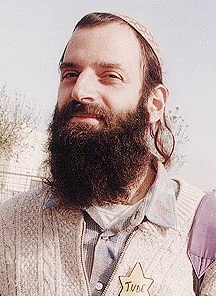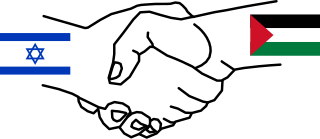
Baruch Kopel Goldstein was an American-Israeli physician, religious extremist, and mass murderer who perpetrated the 1994 Cave of the Patriarchs massacre in Hebron, killing 29 Palestinian Muslim worshippers and wounding another 125. He was beaten to death by survivors of the massacre.

Arab–Israeli peace projects are projects to promote peace and understanding between the Arab League and Israel in different spheres. These are part of a broader attempt at a peace process between Palestinians and Israelis. Sponsors of such projects can be found both in Israel and Palestine.

Beit Shemesh is a city located approximately 30 kilometres (19 mi) west of Jerusalem in Israel's Jerusalem District, with a population of 118,676 in 2018. The history of Beit Shemesh goes back to pre-biblical times. The modern city of Beit Shemesh was founded in 1950.

Amira Hass is an Israeli journalist and author, mostly known for her columns in the daily newspaper Haaretz. She is particularly recognized for her reporting on Palestinian affairs in the West Bank and Gaza, where she has also lived for a number of years.

Kiryat Arba or Qiryat Arba, lit. "Town of the Four," is an urban Israeli settlement on the outskirts of Hebron, in the Judean Mountains region of the West Bank. Founded in 1968, in 2018 it had a population of 7,323.

Gush Etzion is a cluster of Jewish settlements located in the Judaean Mountains, directly south of Jerusalem and Bethlehem in the West Bank. The core group includes four Jewish agricultural villages that were founded in 1940–1947 on property purchased in the 1920s and 1930s, and destroyed by the Arab Legion before the outbreak of the 1948 Arab–Israeli War, in the Kfar Etzion massacre. The area was left outside of Israel with the 1949 armistice lines. These settlements were rebuilt after the 1967 Six-Day War, along with new communities that have expanded the area of the Etzion Bloc. As of 2011, Gush Etzion consisted of 22 settlements with a population of 70,000.

The Cave of the Patriarchs massacre, also known as the Ibrahimi Mosque massacre or Hebron massacre, was a shooting massacre carried out by American-Israeli Baruch Goldstein. Goldstein was a member of the far-right Israeli Kach movement. On February 25, 1994, during the overlapping religious holidays of both Jewish Purim and Muslim Ramadan, Goldstein opened fire on a large number of Palestinian Muslims who had gathered to pray inside the Ibrahimi Mosque at the Cave of the Patriarchs compound in Hebron, West Bank. The attack left 29 people dead, several as young as twelve, and 125 wounded. Goldstein was overpowered, disarmed and then beaten to death by survivors.
David Wilder is a leader of Israeli settlers and the spokesman for The Committee of The Jewish Community of Hebron.

Alon Shvut is an Israeli settlement located southwest of Jerusalem, one kilometer northeast of Kfar Etzion, in the West Bank. Established in June 1970 in the heart of the Etzion bloc, Alon Shvut became the prototype for Jewish communities in the region. It is administered by the Gush Etzion Regional Council, and neighbors the communities of Kfar Etzion, Rosh Tzurim, Neve Daniel, Elazar, and Efrat. In 2018, its population was 3,151.

Beit HaArava is an Israeli settlement and kibbutz in the West Bank. Located near the Dead Sea and Jericho at the eponymous Beit HaArava Junction, the intersection of Highway 1 and Highway 90, it falls under the jurisdiction of Megilot Regional Council. In 2018 it had a population of 290.

Beit Hagai, also Hagai, is an Israeli settlement organized as a community settlement located in the southern Hebron hills in the West Bank. The settlement population was 460 in 2004, according to a classified government document published by the Haaretz newspaper, and lies within the municipal jurisdiction of the Har Hebron Regional Council. The religious Jewish community's name, Haggai, is an acronym of the given names Hanan Krauthammer, Gershon Klein, and Yaakov Zimmerman, three Nir Yeshiva students murdered in the 1980 Hebron terrorist attack. The community rabbi for Beit Hagai is Rabbi Moshe Eliezer Rabinovich (HaLevy). In 2018 it had a population of 635. The international community considers Israeli settlements in the West Bank illegal under international law, but the Israeli government disputes this.

Beit Ummar is a Palestinian town located eleven kilometers northwest of Hebron in the Hebron Governorate. According to the Palestinian Central Bureau of Statistics, in 2016, the town had a population of 17,892 inhabitants. Over 4,800 residents of the town are under the age of 18. Since the Second Intifada, unemployment ranges between 60 and 80 percent due mostly to the inability of residents to work in Israel and a depression in the Palestinian economy. A part of the city straddles Road 60 and due to this, several propositions of house demolition have occurred.

The Hebron massacre refers to the killing of sixty-seven or sixty-nine Jews on 24 August 1929 in Hebron, then part of Mandatory Palestine, by Arabs incited to violence by rumors that Jews were planning to seize control of the Temple Mount in Jerusalem. The event also left scores seriously wounded or maimed. Jewish homes were pillaged and synagogues were ransacked. Some of the 435 Jews who survived were hidden by local Arab families, although the extent of this phenomenon is debated. Soon after, all Hebron's Jews were evacuated by the British authorities. Many returned in 1931, but almost all were evacuated at the outbreak of the 1936–39 Arab revolt in Palestine. The massacre formed part of the 1929 Palestine riots, in which a total of 133 Jews and 110 Arabs were killed, and brought the centuries-old Jewish presence in Hebron to an end.
The Israeli–Palestinian conflict in Hebron refers to an ongoing conflict between Palestinians and Jewish settlers in the West Bank city of Hebron in the context of the Israeli–Palestinian conflict. Hebron has a Palestinian majority, consisting of an estimated 208,750 citizens (2015) and a small Jewish minority, variously numbered between 500 and 800. The H1 sector of Hebron, home to around 170,000 Palestinians, is governed by the Palestinian Authority. H2, which was inhabited by around 30,000 Palestinians is under Israeli military control with an entire brigade in place to protect some 800 Jewish residents living in the old Jewish quarter. As of 2015, Israel has declared that special areas of Hebron's old Quarter constitute a closed military zone. Palestinians shops have been forced to close; despite protests Palestinian women are reportedly frisked by men, and residents, who are subjected every day to repeated body searches, must register to obtain special permits to navigate through the 18 military checkpoints Israel has set up in the city center.

The August 2010 West Bank shooting attack was an attack near the Israeli settlement of Kiryat Arba in the occupied West bank, carried out by Hamas militants. Four Israeli settlers were killed after gunmen attacked their vehicle. The four victims, including a pregnant woman, were civilians from the West Bank settlements of Beit Hagai and Efrat. It was the deadliest Palestinian attack on Israelis in over two years.

Al-Shuhada Street or Shuhada Street, also spelled a-Shuhada Street or ash-Shuhada Street, is a street in Hebron.


















